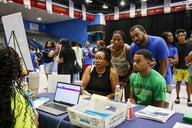You have /5 articles left.
Sign up for a free account or log in.

Students at Curry College in Milton, Mass., shifted online after threats of violence.
Getty Images
It started on Jan. 27 with a swastika and a racist message scrawled in black marker on the wall of a residence hall laundry room at Curry College. More messages appeared in residence hall bathrooms and multipurpose rooms over the following days, and they included “threats of violence,” according to police. After a new threat was made last Tuesday, officials at the Massachusetts college moved all classes scheduled for Feb. 18 and 19 online.
Faculty Chair Bill Nancarrow said the threats left people on campus feeling “frustrated” and “scared.”
“But we’re just trying to get through,” he said. “This has been a tough couple of years for a lot of people in higher education, and this just adds one more layer to the sadness and the difficulty.”
But there is one silver lining, Nancarrow said. Such violent threats could have shut down Curry College in another era, but not in the current COVID era, when colleges have adapted to a deadly public health crisis that demanded social distancing and remote learning and embraced holding class via Zoom. If Curry College’s experience is any indicator, the technological capabilities developed amid COVID are increasingly leading to a new culture on campus where administrators can easily pivot from in-person instruction to online for any number of reasons.
Nancarrow said thanks to technology infrastructure added during the pandemic, moving classes online is now literally as simple as pushing a button.
“We have cameras in the classroom,” he said. “We use Canvas. And we have Zoom links built right into Canvas … You run your class and just do screen share and it’s actually pretty straightforward.” Canvas is a cloud-based learning management system that houses, delivers and tracks all course content, student participation, communication and grades.
Nancarrow said all Curry students and faculty will attend classes online Tuesday because the new threat targets that date. He said since the beginning of the threatening episodes, Curry students and faculty members have had the option to attend remotely “if they’re concerned, and some students and other faculty have taken advantage of that.” He said about 30 percent of his students have been remote in recent days.
“I’ve taught in person each of these days, and if students don’t feel comfortable, they’ve sent me an email, and they zoom in, and I run a hybrid class, just like we did during the pandemic,” Nancarrow said. “We’ve figured out how to do this now.”
Jesse Cinquini, a senior at Curry who has taken his classes online for the past week, said college leaders “made the right decision” to give students and faculty the option to take and teach classes online.
“It has been a smooth transition for me to go fully online,” he said. “All my professors have been very helpful, and they’ve been willing to switch gears and go to Zoom. They were able to move to Zoom seamlessly. There were times I felt uncomfortable when these situations were going on. People didn’t feel as safe, and now we don’t have to worry about that for now, at least.”
Still, he said, “it’s really unfortunate” that the college had to shift online.
“There’s a sign outside of Curry that says ‘hate has no home here.’ It seems that’s not the case right now. It seems like it has a penthouse suite … it’s been hard for students and faculty to focus on the tasks at hand. Just getting work done has been hard. We’ve probably talked about the incidents as much as we have schoolwork for the past week or so. It’s been at the forefront of all of my classes.”
The college’s ability to easily pivot has also come in handy at other times. Nancarrow noted that when other colleges in Boston closed for a snow day recently, Curry just shifted online. He compared that decision to one made by college administrators in the winter of 2015, when the Boston metro area received more than 100 inches of snow in five weeks and Curry had to close, causing students to lose significant seat time while leaders were charged with “coming up with all sorts of crazy seat-time equivalents.”
While faculty members hate having to go online because they’d much rather be with their students, it is great to have a backup option, Nancarrow said.
“We’re able to maintain continuity of learning now that we absolutely would not have been able to do before the pandemic,” he said. “We don’t really plan on doing snow days anymore.”
Nancarrow said Curry College is not alone. He pointed out that just last month, officials at the University of California, Los Angeles, moved classes online after a former philosophy lecturer threatened to kill another professor there.
Other institutions in other parts of the country have stayed open even amid devastating natural disasters. Vincent del Casino, provost and senior vice president for academic affairs at San José State University, said the ability to shift online kept students working despite the harrowing wildfire season in California in the fall of 2020. He said SJSU was operating largely online due to COVID when the wildfires—which would ultimately kill at least 33 people—tore through Northern California that fall. SJSU only had to close for one day due to the fires, he said, since classes were already 95 percent online and it was easy to pivot thanks to what was learned during the pandemic.
“As we continue to think about academic continuity in the wake of not only the pandemic, but also other issues such as wildfires, earthquakes or social events and unrest, we have to have protocols in place to shift, albeit sometimes briefly, from face-to-face to online modalities for a day or a week,” del Casino said by text. “If we have learned anything in the last several years, it is that change and disruption to our academic and business enterprises is the new normal.”
For students, the new normal means they won’t get out of classwork quite as easily as they might have in the past. Wildfires, earthquakes, hurricanes and pandemics can all be worked around from home.
Phil Hill, an educational technology consultant and the author of the popular blog Phil on EdTech, said from now on, “It will be much more common to go to remote for some time versus, ‘Oh, we’re shutting down.’”
“There will be a lot of pressure to not go backwards—you can’t say we’re done with COVID; we don’t need to worry about that [technological] stuff anymore,” Hill said. “Now there’s an expectation that we’re going to keep classes going. You’re going to still have a test and assignments.”




